Facebook photos
Facebook members are best uploading high resolution images for best quality
www.facebook.com/help/187741037945488
or search "facebook How do I upload high-resolution photos?"
www.facebook.com/help/187741037945488
or search "facebook How do I upload high-resolution photos?"
Key points
Getting good photos to paint from with animal subjects is not easy and you need patience, time and concentration!
Key words to remember are POSE, DETAIL, LIGHTING, EXPOSURE & RELAX
Key words to remember are POSE, DETAIL, LIGHTING, EXPOSURE & RELAX
Basics
Always get down to the level of your dog/cat. Don't look down with the camera or up very much.
Get close so I see more detail, but not too close if your lens is wide angle, as many 'point & shoot' camera or mobile lenses tend to distort the dog/cat and exaggerate what is nearest, so creating unnatural proportions. If in doubt, take some close-up and others a little further away.
Avoid movement in the dog/cat or strange expressions - it's best they look directly at you or over your shoulder, but not side-on unless a show dog/cat all body type pose.
Full-body needs 'turning' a little, as it will not look good to me, but head and shoulders can look fine head-on.
Outdoor natural lighting is usually best as flash indoors is difficult to get right and is usually head-on, which flattens the form of the dog/cat and doesn't make pleasing highlights or shadows. Avoid backlighting - white wall, bright light sky, open window when indoors for example, unless you can then over-expose the dog/cat to compensate. If not, move closer so the exposure is not so affected by the backlighting.
Try to get the dog/cat relaxed, maybe tiring out a working or hyper-active dog/cat before the shoot. It can sometimes take two of you to do the shoot well - one with camera, the other to act as something for the dog/cat to focus on, but without that "just lurching forward to them" pose! Take plenty of photos as the more the better for me as some reveal things others do not. If in doubt, look at my work for poses that work as paintings - I have very few where I had no choice, maybe because the dog/cat had passed away and available photos were limited. Mostly I chose from good photos taken by me.
Get close so I see more detail, but not too close if your lens is wide angle, as many 'point & shoot' camera or mobile lenses tend to distort the dog/cat and exaggerate what is nearest, so creating unnatural proportions. If in doubt, take some close-up and others a little further away.
Avoid movement in the dog/cat or strange expressions - it's best they look directly at you or over your shoulder, but not side-on unless a show dog/cat all body type pose.
Full-body needs 'turning' a little, as it will not look good to me, but head and shoulders can look fine head-on.
Outdoor natural lighting is usually best as flash indoors is difficult to get right and is usually head-on, which flattens the form of the dog/cat and doesn't make pleasing highlights or shadows. Avoid backlighting - white wall, bright light sky, open window when indoors for example, unless you can then over-expose the dog/cat to compensate. If not, move closer so the exposure is not so affected by the backlighting.
Try to get the dog/cat relaxed, maybe tiring out a working or hyper-active dog/cat before the shoot. It can sometimes take two of you to do the shoot well - one with camera, the other to act as something for the dog/cat to focus on, but without that "just lurching forward to them" pose! Take plenty of photos as the more the better for me as some reveal things others do not. If in doubt, look at my work for poses that work as paintings - I have very few where I had no choice, maybe because the dog/cat had passed away and available photos were limited. Mostly I chose from good photos taken by me.
Pose
My style of painting animals is fairly traditional, so subjects are usually in a state of equilibrium or if not, they are dynamic, but counter-balanced with other elements within the picture.
A dog/cat leaning forward as if to run is rarely ok, because there is nothing to counter it and the painting becomes 'unstable' and uncomfortable.
A dog/cat jumping for something can sometimes be ok, depending on the context, my http://finest-oil-paintings.com/dog6_detail.html for example has the pheasant to balance the dog.
Hunting scenes like this need other elements apart from the dog itself.
A dog/cat leaning forward as if to run is rarely ok, because there is nothing to counter it and the painting becomes 'unstable' and uncomfortable.
A dog/cat jumping for something can sometimes be ok, depending on the context, my http://finest-oil-paintings.com/dog6_detail.html for example has the pheasant to balance the dog.
Hunting scenes like this need other elements apart from the dog itself.
Detail, lighting & exposure
Form comes from light. Detail comes from light. I need light!
Correct exposure matters. It means I see detail in shadows and highlights and your eye will accept lack of shadow more readily in a photo than a painting.
When we see things in front of us, we see selectively and compensate for extremes of light, being able to 'zoom into' areas and experience a much wider range of tones than any photograph can show us. If I'm using photos, I cannot do this editing without the animal in front of me, so rely on the photos I have.
If you don't know what I am talking about (few people do), then aside from total auto mode of your device, take several photos pointing your camera/mobile at different areas of the scene and using any 'hold' feature to hold that exposure. Look for 'bracketed' exposure features on you device too.
This way we will get a variety of exposures for light and dark areas of the scene, improving the chances of seeing them being correct.
Back to the dog/cat, this means I will see detail in the shadows e.g. under their jaw or larger areas if the subject is lit by a strong side-on light. I will also see detail in tops of heads and noses or even the whole side of such a strongly lit subject.
Detail also comes form being close enough to the subject, partly due to colours becoming more saturated the closer we are to the subject and also due to the resolution limitations of our device.
Flash, unless done well, kills form because it will be head on and not portray form well. It also kills eyes looking good and that's not how you are used to seeing your pet. How I paint the eyes is very important, being such a major element of your connection with your dog/cat.
As said earlier, always try to use natural outdoor lighting, even indoors, such as in a conservatory, which tend to be well lit.
Strong sunlight can actually be worse than a bright but slightly cloudy day, so contrasts are not so high to create exposure headaches.
Correct exposure matters. It means I see detail in shadows and highlights and your eye will accept lack of shadow more readily in a photo than a painting.
When we see things in front of us, we see selectively and compensate for extremes of light, being able to 'zoom into' areas and experience a much wider range of tones than any photograph can show us. If I'm using photos, I cannot do this editing without the animal in front of me, so rely on the photos I have.
If you don't know what I am talking about (few people do), then aside from total auto mode of your device, take several photos pointing your camera/mobile at different areas of the scene and using any 'hold' feature to hold that exposure. Look for 'bracketed' exposure features on you device too.
This way we will get a variety of exposures for light and dark areas of the scene, improving the chances of seeing them being correct.
Back to the dog/cat, this means I will see detail in the shadows e.g. under their jaw or larger areas if the subject is lit by a strong side-on light. I will also see detail in tops of heads and noses or even the whole side of such a strongly lit subject.
Detail also comes form being close enough to the subject, partly due to colours becoming more saturated the closer we are to the subject and also due to the resolution limitations of our device.
Flash, unless done well, kills form because it will be head on and not portray form well. It also kills eyes looking good and that's not how you are used to seeing your pet. How I paint the eyes is very important, being such a major element of your connection with your dog/cat.
As said earlier, always try to use natural outdoor lighting, even indoors, such as in a conservatory, which tend to be well lit.
Strong sunlight can actually be worse than a bright but slightly cloudy day, so contrasts are not so high to create exposure headaches.
Relax
If you stay calm, your dog/cat will be more likely to stay calm, so they settle more into a pose and you think of all this stuff I'm filling your head with!
Examples of poor photographs to paint from
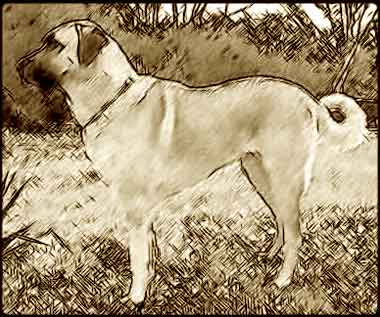
Dog's head and body is too much in profile making picture flat. It even looks as if he only has one front leg!
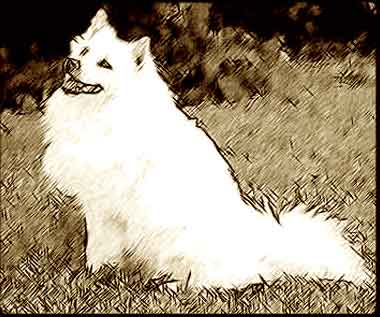
Almost there, but head would be better more level and looking more towards us. Beware of bleached out over-exposed light colours, as with white dogs - I need to see detail in that fur.
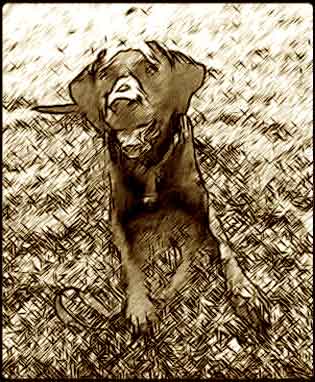
Looking down on dog. Rear leg a bit awkward. Where is the other rear leg? Dog is black, but exposure is not bad (I can see in highlights and shadows) - it's very easy to get light and dark subject wrongly exposed. Always take plenty of shots of such animals.
Wide angle lens distorts dog, so best step back_a_bit to correct this - I can use one photo as my main photo and another similar close-up to see details.
Wide angle lens distorts dog, so best step back_a_bit to correct this - I can use one photo as my main photo and another similar close-up to see details.
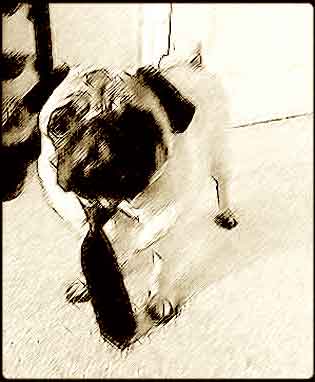
Again looking down to dog, which we all tend to do with smaller dogs - time to get on hands and knees or put dog on a pedestal!
Face is a bit under-exposed so I can't see detail on his left side.
Face is a bit under-exposed so I can't see detail on his left side.
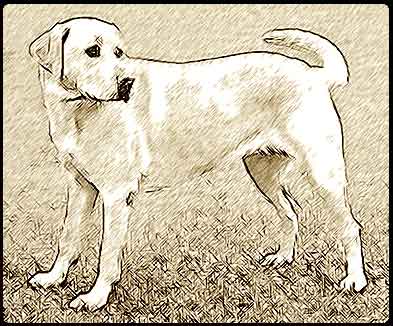
A bit too square with the legs and tail 'droopy' - nearly a good picture.
Head would have been better looking towards us or over our left shoulder.
Watch exposure on backs and nose in strong sunlight.
Head would have been better looking towards us or over our left shoulder.
Watch exposure on backs and nose in strong sunlight.
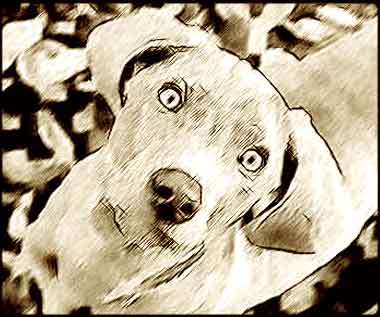
Guess?
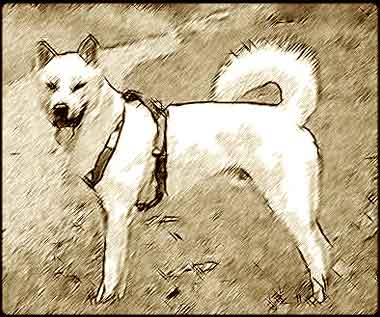
Quite ok, but body a bit too side-on, slightly turned towards us would look better for a painting.
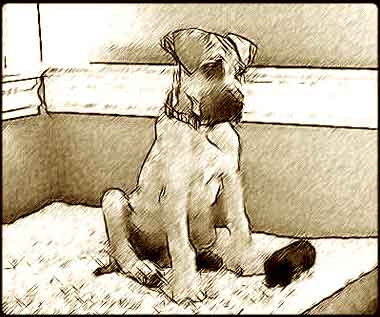
Would have been fine had he looked towards us of just to our side.
Exposure good, body good - we accept awkwardness more with younger dog/cats.
Exposure good, body good - we accept awkwardness more with younger dog/cats.
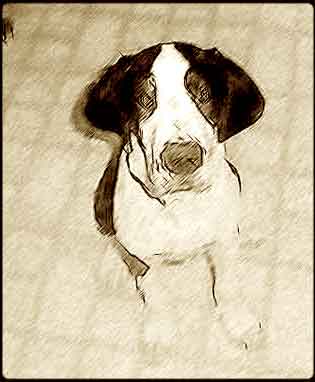
Looking down too much again.
There was over-exposure of light areas so I can't see much detail and front-facing flash flattening the form and creating a horrible shadow behind the dog. Light from the sides and a little infront of the subject is always good to show form and eyes (well at least one of them!).
There was over-exposure of light areas so I can't see much detail and front-facing flash flattening the form and creating a horrible shadow behind the dog. Light from the sides and a little infront of the subject is always good to show form and eyes (well at least one of them!).
Examples of good photographs to paint from
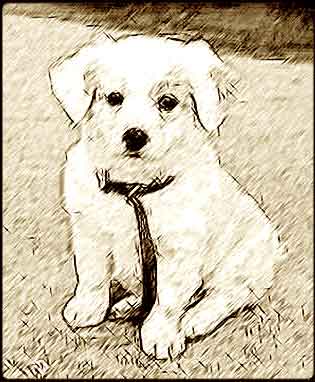
Not looking down too much on the dog, balanced posture and dog looking towards us without a silly expression (which works fine for photos and certain art, but it's not for my style of painting).
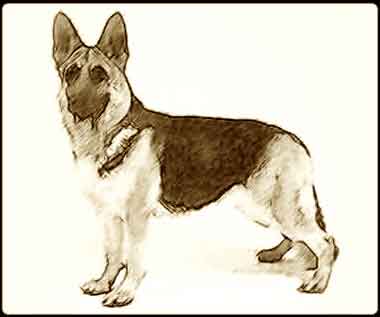
Good stance, all legs visible, paws not awkwardly placed (always check these with full poses eg are the obscured by vegetation? are they settled in a position the visually fits the leg position?
The head is not perfectly head-on to us (which isn't so good with a full-body pose) or too side-on, looking over our left shoulder.
Exposure was good; by which I mean I could see detail most places on the dog and without adding exposure here, an auto expose camera would have likely under-exposed the subject, depending on how smart it is.
The head is not perfectly head-on to us (which isn't so good with a full-body pose) or too side-on, looking over our left shoulder.
Exposure was good; by which I mean I could see detail most places on the dog and without adding exposure here, an auto expose camera would have likely under-exposed the subject, depending on how smart it is.
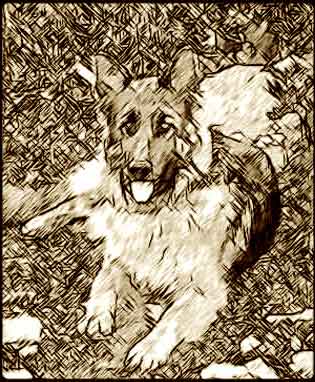
Not looking down too much with a pleasant asymmetric pose.
Exposure was good, expression was good (watch tongues as they can look weird!
Tail cut-off in picture, but I can figure out a tail easier than a paw.
Exposure was good, expression was good (watch tongues as they can look weird!
Tail cut-off in picture, but I can figure out a tail easier than a paw.
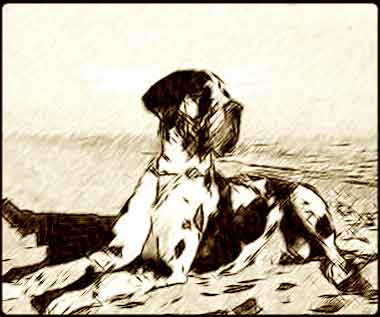
Pleasing natural sitting pose, exposed ok and light good to highlight chest and face (rather than from the right, which would have put the visible side of the head into shadow.
The twist of the head across the body makes an interesting depth to the picture and balances for an equilibrium.
The twist of the head across the body makes an interesting depth to the picture and balances for an equilibrium.
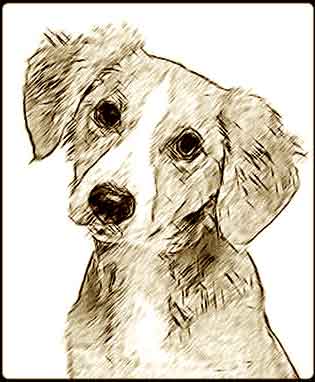
Exposure was good with detail all over dog made easier by lighting not being too bright.
Tilt of head is good, but any more would have ruined it as a painting for me.
Face is not perfectly straight on, which makes a slightly more interesting pose than head-on (but this can suit a confrontational pose, as suitable for a gaurd dog.
Tilt of head is good, but any more would have ruined it as a painting for me.
Face is not perfectly straight on, which makes a slightly more interesting pose than head-on (but this can suit a confrontational pose, as suitable for a gaurd dog.
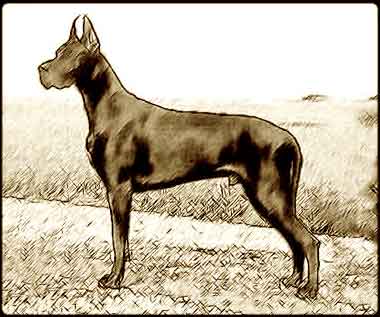
Just about ok with a turn of the head to counter the profile of the body and luckily the legs are just all visible at the rear, even if not at the front.
Exposure was good with light from right to highlight visible side of head.
Ears also positioned ok (they can look silly at times).
Exposure was good with light from right to highlight visible side of head.
Ears also positioned ok (they can look silly at times).
Remember pose, detail, lighting, exposure and RELAX!
What works fine as a photo doesn't work for my kind of painting - I'm just an old-fashioned kinda guy.
What works fine as a photo doesn't work for my kind of painting - I'm just an old-fashioned kinda guy.